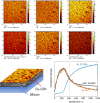Antibacterial Inorganic Coating of Calcium Silicate Hydrate Substrates by Copper Incorporation
- PMID: 36280235
- PMCID: PMC9683100
- DOI: 10.1021/acsabm.2c00616
Antibacterial Inorganic Coating of Calcium Silicate Hydrate Substrates by Copper Incorporation
Abstract
Under environmental conditions, biofilms can oftentimes be found on different surfaces, accompanied by the structural degradation of the substrate. Since high-copper-content paints were banned in the EU, a solution for the protection of these surfaces has to be found. In addition to hydrophobation, making the surfaces inherently biofilm-repellent is a valid strategy. We want to accomplish this via the metal exchange in calcium silicate hydrate (CSH) substrates with transition metals. As has been shown with Europium, even small amounts of metal can have a great influence on the material properties. To effectively model CSH surfaces, ultrathin CSH films were grown on silicon wafers using Ca(OH)2 solutions. Subsequently, copper was incorporated as an active component via ion exchange. Biofilm development is quantified using a multiple-resistant Pseudomonas aeruginosa strain described as a strong biofilm former cultivated in the culture medium for 24 h. Comprehensive structural and chemical analyses of the substrates are done by environmental scanning electron microscopy (ESEM), transmission Fourier transform infrared spectroscopy (FT-IR), X-ray photoelectron spectroscopy (XPS), and time-of-flight secondary ion mass spectrometry (ToF-SIMS). Results do not show any structural deformation of the substrates by the incorporation of the Cu combined with three-dimensional (3D) homogeneous distribution. While the copper-free CSH phase shows a completely random distribution of the bacteria in biofilms, the samples with copper incorporation reveal lower bacterial colonization of the modified surfaces with an enhanced cluster formation.
Keywords: antibacterial; calcium silicate hydrate; cement; coating; copper; inorganic.
Conflict of interest statement
The authors declare no competing financial interest.
Figures





References
-
- Pan S.; Richardson J. J.; Christofferson A. J.; Besford Q. A.; Zheng T.; Wood B. J.; Duan X.; Jara Fornerod M. J.; McConville C. F.; Yarovsky I.; Guldin S.; Jiang L.; Caruso F. Fluorinated Metal–Organic Coatings with Selective Wettability. J. Am. Chem. Soc. 2021, 143, 9972–9981. 10.1021/jacs.1c04396. - DOI - PubMed
-
- Taylor S. R.22-The Role of Intrinsic Defects in the Protective Behavior of Organic Coatings. In Handbook of Environmental Degradation of Materials, 2nd ed.; Kutz M., Ed.; William Andrew Publishing: Oxford, 2012; pp 655–672.
-
- Ryan E. J.; Ryan A. J.; González-Vázquez A.; Philippart A.; Ciraldo F. E.; Hobbs C.; Nicolosi V.; Boccaccini A. R.; Kearney C. J.; O’Brien F. J. Collagen scaffolds functionalised with copper-eluting bioactive glass reduce infection and enhance osteogenesis and angiogenesis both in vitro and in vivo. Biomaterials 2019, 197, 405–416. 10.1016/j.biomaterials.2019.01.031. - DOI - PubMed
Publication types
MeSH terms
Substances
LinkOut - more resources
Full Text Sources
Medical
Research Materials

